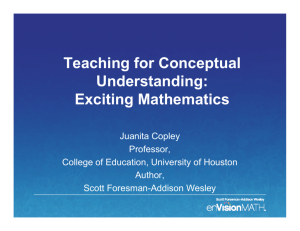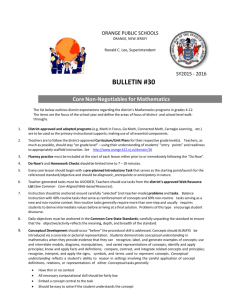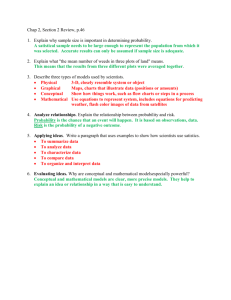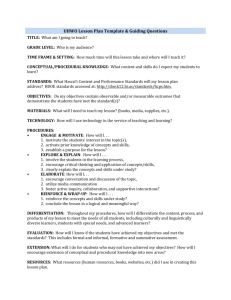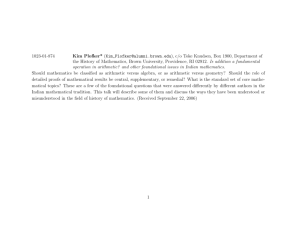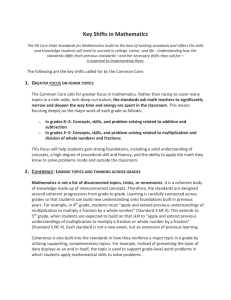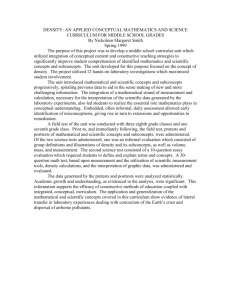Is It True That Some People Just Can't Do Math?
advertisement
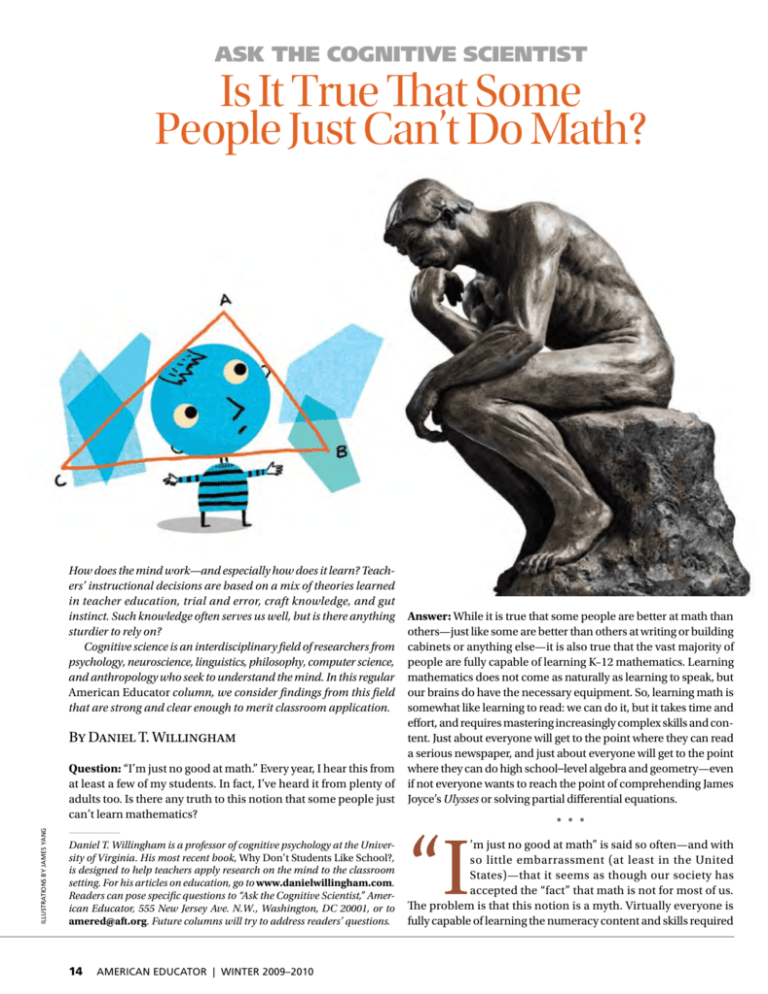
Ask the Cognitive Scientist Is It True That Some People Just Can’t Do Math? How does the mind work—and especially how does it learn? Teachers’ instructional decisions are based on a mix of theories learned in teacher education, trial and error, craft knowledge, and gut instinct. Such knowledge often serves us well, but is there anything sturdier to rely on? Cognitive science is an interdisciplinary field of researchers from psychology, neuroscience, linguistics, philosophy, computer science, and anthropology who seek to understand the mind. In this regular American Educator column, we consider findings from this field that are strong and clear enough to merit classroom application. By Daniel T. Willingham ILLUSTRATIONS BY JAMES YANG Question: “I’m just no good at math.” Every year, I hear this from at least a few of my students. In fact, I’ve heard it from plenty of adults too. Is there any truth to this notion that some people just can’t learn mathematics? Daniel T. Willingham is a professor of cognitive psychology at the University of Virginia. His most recent book, Why Don’t Students Like School?, is designed to help teachers apply research on the mind to the classroom setting. For his articles on education, go to www.danielwillingham.com. Readers can pose specific questions to “Ask the Cognitive Scientist,” American Educator, 555 New Jersey Ave. N.W., Washington, DC 20001, or to amered@aft.org. Future columns will try to address readers’ questions. 14 AMERICAN EDUCATOR | WINTER 2009–2010 Answer: While it is true that some people are better at math than others—just like some are better than others at writing or building cabinets or anything else—it is also true that the vast majority of people are fully capable of learning K–12 mathematics. Learning mathematics does not come as naturally as learning to speak, but our brains do have the necessary equipment. So, learning math is somewhat like learning to read: we can do it, but it takes time and effort, and requires mastering increasingly complex skills and content. Just about everyone will get to the point where they can read a serious newspaper, and just about everyone will get to the point where they can do high school–level algebra and geometry—even if not everyone wants to reach the point of comprehending James Joyce’s Ulysses or solving partial differential equations. “I * * * ’m just no good at math” is said so often—and with so little embarrassment (at least in the United States)—that it seems as though our society has accepted the “fact” that math is not for most of us. The problem is that this notion is a myth. Virtually everyone is fully capable of learning the numeracy content and skills required for good citizenship: an understanding of arithmetic procedures, algebra, geometry, and probability deep enough to allow application to problems in our daily lives. What Does Nature Provide? Humans have a clear proclivity to learn some types of information. The most notable example is language; given normal linguistic input, virtually all children learn their native language without effort or explicit instruction. In fact, we seem to have some innate knowledge of grammatical structures; our minds are so biased to learn language, we will improve on imperfect linguistic input. Deaf children exposed only to crude signs have been observed modifying what they see to give it more linguistic structure.1 Is something comparable true of mathematics? Just how “naturally” do children learn mathematics? Two important findings from the last 20 years are relevant: (1) humans are born with the ability to appreciate the concept of number, and (2) humans seem to be born with a sense that numbers and space are related. Let’s discuss each of these briefly. First, humans are born with two ways to appreciate number. One is an approximate number sense. This sense cannot support precise enumeration, but it does enable us to compare two sets of objects and immediately know which set is larger. For example, if you saw 50 beans scattered on one table and 100 beans on another table, you would know at a glance, without counting, which table had more beans on it. Carefully conducted laboratory tests confirm that people can use their natural sense of numerosity to make these judgments, and are not making judgments by the area taken up by the beans, the density, or other cues.2 Although infants cannot give verbal replies, we know that they can make these judgments as well. Infants look at a novel object until they grow bored with it. If a new object is presented, they will look at it; but if the same object is presented, they will look at it for a much shorter time. By measuring looking time, an experimenter can determine whether the infant perceives a difference between the first and second objects. Using this methodology, studies have determined that infants have this approximate number sense,3 although it is not as fine-grained as that seen in older children or adults. Six-montholds can appreciate differences in numerosity in a ratio of 2:1 or larger, whereas adults can appreciate 8:7 (e.g., without counting, infants can tell that there is a difference between a group of four dots and a group of eight dots, while adults can tell that there is a difference between a group of seven dots and a group of eight dots). There is good evidence that nonhuman primates4 and rats5 also have approximate number sense. The other way in which humans are born with an appreciation of number is that we have a way of representing precise values in our minds, but only up to a value of three. For example, if 10-monthold infants watch as one cracker is put into one bucket and then two crackers are put into another bucket, they crawl to the bucket with two crackers. They also choose three crackers over two, but fail when comparing two versus four.6 A comparable experiment testing untrained rhesus monkeys showed similar performance; in fact, they performed slightly better than human infants, with an ability to mentally represent quantities of four.7 Adults can perceive numerosities of up to four more or less instantly and virtually error free. Errors and response times increase sharply as the number of objects increases beyond four.8 The other important finding from the last 20 years of research is that humans seem to be born with a sense that numbers and space are related. There is a variety of evidence for this relationship; we’ll review just a handful of it. First, many cultures make use of a spatial representation of numbers, for example, via a number line. Second, numbers and space are represented in overlapping areas of the brain. Damage to a particular region of the brain (the intraparietal sulcus, which is on the upper part of the brain, toward the back) leads to difficulties with directing spatial attention and difficulties with processing numbers.9 In one of the more interesting demonstrations of the overlap of Virtually everyone is fully capable of understanding arithmetic procedures, algebra, geometry, and probability deeply enough to allow application to problems in our daily lives. mathematics and space, a group of researchers wrote a computer program that analyzed brain imaging data to classify whether subjects were moving their eyes rightward or leftward during a brain scan.10 The researchers then applied the classification program to brain data from subjects who performed two utterly different tasks: addition and subtraction. The theory was that, given the relationship between numbers and space, subtraction is like leftward eye movements because it decreases number size, and addition is like rightward eye movements because it increases number size. Remarkably, the computer program (created with just the brain data from eye movements) was successful 70 percent of the time in predicting whether subjects were adding or subtracting numbers. Still, how we express our inborn sense that numbers and space are related is clearly affected by culture, as revealed in the following experiment. Subjects are seated in front of a computer screen and have two buttons. On each trial, a digit appears on the screen, and subjects are told to push the button on the left if the digit is even and the button on the right if it is odd. When an even digit appears, subjects are faster to push the left button for small num- AMERICAN EDUCATOR | WINTER 2009–2010 15 bers (two or four) than larger numbers (six or eight). When an odd digit appears, they are faster to push the right button for larger numbers (seven or nine) than smaller ones (one or three). In other words, small numbers “belong” on the left side, and large numbers “belong” on the right. This widely replicated effect is not observed until children are about 9 years old,11 and it is reversed in Iranian adults who read from right to left.12 Thus, it seems quite likely that, even if it is natural to associate space with number, the manner in which this happens is learned, and is specific to cultural convention. The ability to enumerate precisely beyond about four depends on another, culture-specific system that is learned, and that is supported by language. In short, we learn to count. One of the most dramatic sources of evidence to help researchers understand Automatic retrieval of basic math facts is critical to solving complex problems because complex problems have simpler problems embedded in them. They both allocate more space on the line to smaller quantities and less space to larger quantities, with crowding increasing as they get closer to 100.14 So it appears that humans are born with a sense of number as spatial, but the space is not linear. Indeed, until they have had sufficient experience (mostly in school) with the linear one-to-one correspondence between number and space that characterizes the number line, American children perform the place-the-dotson-the-line task as the Mundurucú do. While American firstgraders crowd higher numbers together, third-graders space higher numbers more evenly, and second-graders will do one or the other, depending on the task, the day of testing, and other incidental factors.15 S o what comes naturally to children in mathematics? They have a natural number sense that allows them to understand and manipulate very small quantities with precision, and much larger quantities in approximation. Those abilities are, of course, a far cry from the abilities teachers hope to develop in their students, but they are the base upon which teachers must build. Just as reading does not come naturally, but uses visual and language representations that are natural,16 it’s a good bet that mathematics uses mental representations that are natural, but that did not evolve to support mathematics in the way our advanced society now needs them to.17 For educators, that means we should not expect students will learn mathematics with ease. Rather, we should expect that mathematical proficiency will require careful cultivation and will develop slowly. At the same time, we should keep in mind that students are born with the ability to learn math, and we should not let students give up by concluding that they’re just no good at math. What Do Students Need to Be Successful in Math? counting as a culture-specific system comes from tests of the Mundurucú, an Amazonian indigen group. Their language has words for numbers only up to five. Beyond five, they simply refer to “many.” They can use their innate approximate-number system to estimate and to roughly perform addition, but they cannot perform precise arithmetic with numbers larger than five.13 The Mundurucú have a sense of numbers corresponding to space, but this correspondence is not linear. That is, unlike on a ruler or number line, each increase of one number is not matched by a uniform increase in space. If asked to point to a location on a line to indicate where 1 to 10 dots should be represented, the Mundurucú will place the quantities 1 through 5 relatively spread out, and the quantities 6 through 10 more crowded together: the difference between 2 and 3 will be bigger than the difference between 7 and 8.* American adults, in contrast, do have a linear sense of number and space: they space the quantities 1 through 10 equally, as on a number line. But, American adults’ linear sense is limited to situations where they are counting. When asked to perform the same task with quantities of dots between 10 and 100, Mundurucú and American participants perform comparably. *The relationship between number and space is actually logarithmic. In its recent report,† the National Mathematics Advisory Panel argued that learning mathematics requires three types of knowledge: factual, procedural, and conceptual. Let’s take a close look at each. Factual knowledge refers to having ready in memory the answers to a relatively small set of problems of addition, subtraction, multiplication, and division.‡ The answers must be well learned so that when a simple arithmetic problem is encountered (e.g., 2 + 2), the answer is not calculated but simply retrieved from memory. Moreover, retrieval must be automatic (i.e., rapid and virtually attention free). This automatic retrieval of basic math facts is critical to solving complex problems because complex problems have simpler problems embedded in them. For example, long division problems have simpler subtraction problems embedded in them. Students who automatically retrieve the answers to the simple subtraction problems keep their working memory (i.e., the mental “space” in which thought occurs) free to focus on the bigger long division problem.18 The less working memory a student must devote to the subtraction subproblems, the more likely that student is to solve ‡ Addition and multiplication facts are easier to memorize because they are commutative; that is, 3 + 4 is the same as 4 + 3, and the same is true for 3 x 4 and 4 x 3. That is not the case for subtraction and division. Even well-educated adults from countries with excellent math education will sometimes calculate subtraction and division facts, rather than retrieve them from memory. †The National Mathematics Advisory Panel’s report is available at 16 AMERICAN EDUCATOR | WINTER 2009–2010 www.ed.gov/about/bdscomm/list/mathpanel/report/final-report.pdf. the long division problem. This interpretation of the importance of memorizing math facts is supported by several sources of evidence. First, it is clear that before they are learned to automaticity, calculating simple arithmetic facts does indeed require working memory. With enough practice, however, the answers can be pulled from memory (rather than calculated), thereby incurring virtually no cost to working memory.19 Second, students who do not have math facts committed to memory must instead calculate the answers, and calculation is more subject to error than memory retrieval.20 Third, knowledge of math facts is associated with better performance on more complex math tasks.21 Fourth, when children have difficulty learning arithmetic, it is often due, in part, to difficulty in learning or retrieving basic math facts.22 One would expect that interventions to improve automatic recall of math facts would also improve proficiency in more complex mathematics. Evidence on this point is positive23 but limited, perhaps because automatizing factual knowledge poses a more persistent problem than difficulties related to learning mathematics procedures.24 What of procedural and conceptual knowledge, also deemed necessary by the National Mathematics Advisory Panel? A procedure is a sequence of steps by which a frequently encountered problem may be solved. For example, many children learn a routine of “borrow and regroup” for multidigit subtraction problems. Conceptual knowledge refers to an understanding of meaning; knowing that multiplying two negative numbers yields a positive result is not the same thing as understanding why it is true. The “math wars” that have been waged among math educators and researchers in the United States have largely revolved around the procedures-versus-concepts axis and, like most heated debates, have included a fair amount of caricature. At the extremes, progressives claim that traditionalists would be happy for students to execute procedures without understanding what they are doing, and traditionalists claim that progressives care only that students understand concepts and are unconcerned about whether they can actually solve math problems. Most observers of the math wars understand that, even though some children with conceptual understanding may invent appropriate calculation procedures,25 this process of invention cannot be relied on for all children.26 Then too, knowledge of procedures is no guarantee of conceptual understanding; for example, many children can execute a procedure to divide fractions without understanding why the procedure works.27 Most observers agree that knowledge of procedures and concepts is desirable.28 Somewhat more controversial is the relative emphasis that should be given to these two types of knowledge, and the order in which students should learn them. Perhaps with sufficient practice and automaticity of algorithms, students will, with just a little support, gain a conceptual understanding of the procedures they have been executing. Or perhaps with a solid conceptual understanding, the procedures necessary to solve a problem will seem self-evident. There is some evidence to support both views. Conceptual knowledge sometimes seems to precede procedural knowledge or to influence its development.29 Then too, procedural knowledge can precede conceptual knowledge. For example, children can often count successfully before they understand all of counting’s properties, such as the irrelevance of order.30 A third point of view (and today perhaps the most commonly accepted) is that for most topics, it does not make sense to teach concepts first or to teach procedures first; both should be taught in concert. As students incrementally gain knowledge and understanding of one, that knowledge supports comprehension of the other.31 Indeed, this stance seems like common sense. Since neither procedures nor concepts arise quickly and reliably in most students’ minds without significant prompting, why wouldn’t one teach them in concert? The Problem of Conceptual Knowledge How well are American students doing on these three types of knowledge? The National Mathematics Advisory Panel concluded that American students have reasonable, though incomplete, fac- For most topics, it does not make sense to teach concepts first or to teach procedures first; both should be taught in concert. Gaining knowledge and understanding of one supports comprehension of the other. tual and procedural knowledge, and poor conceptual knowledge. These conclusions seem sound, but they ought to be considered tentative because there are not up-to-date, comprehensive assessments designed to provide this sort of data. Still, studies from the last 20 years indicate that American students, even college students, have not completely automatized fact retrieval32 or achieved fluency with procedures.33 More troubling is American students’ lack of conceptual understanding. Several studies have found that many students don’t fully understand the base-10 number system.34 A colleague recently brought this to my attention with a vivid anecdote. She mentioned that one of her students (a freshman at a competitive university) argued that 0.015 was a larger number than 0.05 because “15 is more than 5.” The student could not be persuaded otherwise. Another common conceptual problem is understanding that an equal sign ( = ) refers to equality—that is, mathematical equivalence. By some estimates, as few as 25 percent of American sixthgraders have a deep understanding of this concept.35 Students often think it signifies “put the answer here.” It has been argued that student textbooks and textbooks for future mathematics teachers do not make the meaning of the equal sign clear enough, AMERICAN EDUCATOR | WINTER 2009–2010 17 nor do they offer examples of its use that would help readers understand the meaning.36 The cost of poor conceptual understanding should be clear. If you think an equal sign means “put the answer here,” you’ll be confused the first time you see an equation with terms on both sides of the equal sign. When a student first encounters factoring, he ought to see how it relates to division, but he probably won’t without a deep conceptual understanding of division. (And, just to emphasize that factual, procedural, and conceptual knowledge all go together, he also will be slowed in factoring if he hasn’t memorized the multiplication table.) Unfortunately, of the three varieties of knowledge that students need, conceptual knowledge is the most difficult to acquire. It’s difficult because knowledge is never acquired de novo; a teacher Manipulatives don’t always help learning— they sometimes impede it. It’s familiarity that helps, because it allows students to think in new ways about things they already know. cannot pour concepts directly into students’ heads. Rather, new concepts must build upon something that students already know. That’s why examples are so useful when introducing a new concept.37 Indeed, when someone provides an abstract definition (e.g., “The standard deviation is a measure of the dispersion of a distribution.”), we usually ask for an example (such as, “Two groups of people might have the same average height, but one group has many tall and many short people, and thus has a large standard deviation, whereas the other group mostly has people right around the average, and thus has a small standard deviation.”). This is also why conceptual knowledge is so important as students advance. Learning new concepts depends on what you already know, and as students advance, new concepts will increasingly depend on old conceptual knowledge. For example, understanding algebraic equations depends on the right conceptual understanding of the equal sign. If students fail to gain conceptual understanding, it will become harder and harder to catch up, as new conceptual knowledge depends on the old. Students will become more and more likely to simply memorize algorithms and 18 AMERICAN EDUCATOR | WINTER 2009–2010 apply them without understanding. So how can students learn concepts? In the United States, much is made of the use of manipulatives to help children understand abstract concepts in mathematics, but of course manipulatives themselves are abstract (the student is to treat them as a symbol for something else38) and manipulatives don’t always help learning—they sometimes impede it.39 This is most likely when manipulatives are so visually interesting that they distract from their purpose, or when their relationship to the concept to be represented is obscure. Manipulatives seem helpful because they are concrete. To illustrate the idea of a fraction, one might divide a cookie in two for the purpose of sharing it with a student. But the concreteness of this example is likely less important than its familiarity.40 Suppose I tore a book into two pieces, and said “See? Now there are two equal pieces. Each one is half a book.” That example is concrete, but less effective because it is unfamiliar; the student has no experience with divided books, and the purpose of sharing is also missing. Concreteness is not a magical property that allows teachers to pour content into students’ minds. It’s familiarity that helps, because it allows the teacher to prompt students to think in new ways about things they already know. Familiarity is not the only ingredient necessary for successful examples. Students are more likely to understand abstract ideas when they see many examples,41 so that they can learn which properties are important to the concept (division of the object into equal parts) and which properties are incidental (that the resulting parts can be shared). Crucially, students frequently fail to understand the concept if they are not explicitly told to look for the commonalities among examples, or are not given hints as to what the commonalities are.42 As concepts become more complex, familiar examples from the students’ lives become harder to generate, and teachers may use analogies more often; a familiar situation is offered as analogous to the concept, not as an example of the concept. Thus, a teacher might tell students that algebraic equations may be thought of like a balance scale: the two sides are equivalent, and you maintain their equivalence so long as you perform the same operation on both sides. Laboratory studies have revealed several principles that make analogies especially effective: familiarity (e.g., students know what a balance scale is), vividness (actually having the balance scale for students to see), making the alignment plain (e.g., writing the two sides of the equation over the two sides of a drawing of a balance scale), and continuing to reinforce the analogy (e.g., by referring to the scale at appropriate times as the equation is solved). Some data indicate that math teachers in Hong Kong and Japan (where mathematics achievement is consistently high) are especially effective in using analogies according to these principles.43 What Does All This Mean for Teaching? 1. Think carefully about how to cultivate conceptual knowledge, and find an analogy that can be used across topics. Of the three types of knowledge mentioned, conceptual knowledge is the most difficult for students to learn. Seeing and hearing many different examples of a concept are useful for abstracting the core idea and learning which features of the examples are irrelevant. It is also useful for students to learn a single analogy to which they return again and again. Using the same analogy across topics makes it much clearer to students how those topics relate to one another. Drawing connections among mathematical topics deepens conceptual knowledge, but it is one of the desired outcomes that is seldom met in the United States. In contrast, drawing connections by building systematically upon simple models is the centerpiece of the Singapore method,44 which appears to be quite successful given the high performance of Singapore’s students. Teachers in the United States may not be free to adopt a curriculum wholesale, but the cognitive advantages of the model approach (see box below) are impressive. The Singapore Model Method uses graphical models to help students understand mathematical concepts. These models are introduced in early grades starting with real objects, but quickly transition to bars, as shown in the two examples below. Both models can represent the same function, in this case addition. 1. The part-whole model emphasizes that two parts of a bar, such as the 5 sections and 3 sections shown here, can also be considered together as a whole with 8 sections. Increased conceptual knowledge may help the average American student move from bare competence with facts and procedures to the automaticity needed to be a good problem solver. But if we reduce work on facts and procedures, the result is likely to be disastrous. 3. In teaching procedural and factual knowledge, ensure that students get to automaticity. Explain to students that automaticity with procedures and facts is important because it frees their minds to think about concepts. For automaticity with procedural knowledge, ensure that students are fluent with the standard algorithms. This requires some memorization and ample practice. For factual knowledge, ensure that students have memorized basic math facts, such as the multiplication table up to 12 x 12. Increased conceptual knowledge may help students move from bare competence with facts and procedures to the automaticity they need to be good problem solvers. ←––––––––––8–––––––––––→ ←––––––5––––––→←–––3–––→ 2. The comparison model emphasizes comparison of two bars. For example, students might use this model to represent the following problem:* Betty saved $121. She saved $63 less than Meilin. How much did Meilin save? ? $ 121 ←––––-––––→ $ 63 In higher grades, these bars easily transition to number lines. The two models can be used for many of the fundamental concepts through algebra: the four operations, fractions, ratios, and percentages. *Kho Tek Hong, Yeo Shu Mei, and James Lim, The Singapore Model Method for Learning Mathematics (Singapore: PanPac, 2009), 20. 2. In cultivating greater conceptual knowledge, don’t sacrifice procedural or factual knowledge. Procedural or factual knowledge without conceptual knowledge is shallow and is unlikely to transfer to new contexts, but conceptual knowledge without procedural or factual knowledge is ineffectual. Tie conceptual knowledge to procedures that students are learning so that the “how” has a meaningful “why” associated with it; one will reinforce the other.† † For an in-depth look at how to teach so that conceptual, factual, and procedural knowledge reinforce each other, see “Basic Skills versus Conceptual Understanding: A Bogus Dichotomy in Mathematics Education” by Hung-Hsi Wu in the Fall 1999 issue of American Educator, available online at www.aft.org/pubs-reports/american_ educator/fall99/wu.pdf. 4. Choose a curriculum that supports conceptual knowledge. If conceptual knowledge is indeed so difficult to learn, it makes sense to (1) study just a few concepts each year, but study them in depth so there is sufficient time to comprehend one concept before the next one is introduced, and (2) sequence topics so, as much as is possible, the mental distance between concepts is small and the previously learned concept will help in learning each new one. These two sensible precepts (along with a third, rigor) are exactly those that William Schmidt has advocated, based on his analysis of the curricula of countries that excel in mathematics.‡ 5. Don’t let it pass when a student says “I’m just no good at math.” We hear it a lot, but it’s very seldom true. It may be true that the student finds math more difficult than other subjects, but with some persistence and hard work, the student can learn math— and as he learns more, it will get easier. By attributing the diffi(Continued on page 39) ‡ To learn more about William Schmidt’s research and the need for focus, coherence, and rigor in mathematics curricula, see “What’s Missing from Math Standards?” in the Spring 2008 issue of American Educator, available online at www.aft.org/ pubs-reports/american_educator/issues/spring2008/schmidt.htm. AMERICAN EDUCATOR | WINTER 2009–2010 19 Ask the Cognitive Scientist (Continued from page 19) culty to an unchanging quality within himself, the student is saying that he’s powerless to succeed. ☐ Endnotes 1. Ann Senghas, Sotaro Kita, and Asli Özyürek, “Children Creating Core Properties of Language: Evidence from an Emerging Sign Language in Nicaragua,” Science 305, no. 5691 (2004): 1779–1782. 2. Michiel P. van Oeffelen and Peter G. Vos, “A Probabilistic Model for the Discrimination of Visual Number,” Perception and Psychophysics 32, no. 2 (1982): 163–170; and Elise Temple and Michael I. Posner, “Brain Mechanisms of Quantity Are Similar in 5-Year-Old Children and Adults,” Proceedings of the National Academy of Sciences 95, no. 13 (1998): 7836–7841. 3. Elizabeth M. Brannon, “The Development of Ordinal Numerical Knowledge in Infancy,” Cognition 83, no. 3 (2002): 223–240; and Fei Xu and Elizabeth S. Spelke, “Large Number Discrimination in 6-Month-Old Infants,” Cognition 74, no. 1 (2000): B1–B11. 4. Elizabeth M. Brannon and Herbert S. Terrace, “Ordering of the Numerosities 1 to 9 by Monkeys,” Science 282, no. 5389 (1998): 746–749. 5. Warren H. Meck and Russell M. Church, “A Mode Control Model of Counting and Timing Processes,” Journal of Experimental Psychology: Animal Behavior Processes 9, no. 3 (1983): 320–334. 6. Lisa Feigenson, Susan Carey, and Marc Hauser, “The Representations Underlying Infants’ Choice of More: Object Files versus Analog Magnitudes,” Psychological Science 13, no. 2 (2002): 150–156. 7. Marc D. Hauser, Susan Carey, and Lilan B. Hauser, “Spontaneous Number Representation in Semi-Free-Ranging Rhesus Monkeys,” Proceedings of the Royal Society of London, B: Biological Sciences 267, no. 1445 (2000): 829–833. 8. Lana M. Trick and Zenon W. Pylyshyn, “Why Are Small and Large Numbers Enumerated Differently? A LimitedCapacity Preattentive Stage in Vision,” Psychological Review 101, no. 1 (1994): 80–102. 9. Arthur L. Benton, “Gerstmann’s Syndrome,” Archives of Neurology 49, no. 5 (1992): 445–447. 10. André Knops et al., “Recruitment of an Area Involved in Eye Movements during Mental Arithmetic,” Science 324, no. 5934 (2009): 1583–1585. 11. Daniel B. Berch et al., “Extracting Parity and Magnitude from Arabic Numerals: Developmental Changes in Number Processing and Mental Representation,” Journal of Experimental Child Psychology 74, no. 4 (1999): 286–308. 12. Stanislas Dehaene, Serge Bossini, and Pascal Giraux, “The Mental Representation of Parity and Number Magnitude,” Journal of Experimental Psychology: General 122, no. 3 (1993): 371–396. 13. Pierre Pica et al., “Exact and Approximate Arithmetic in an Amazonian Indigene Group,” Science 306, no. 5695 (2004): 499–503. 14. Stanislas Dehaene et al., “Log or Linear? Distinct Intuitions of the Number Scale in Western and Amazonian Indigene Cultures,” Science 320, no. 5880 (2008): 1217–1220. 18. Kerry Lee, Ee Lynn Ng, and Swee Fong Ng, “The Contributions of Working Memory and Executive Functioning to Problem Representation and Solution Generation in Algebraic Word Problems,” Journal of Educational Psychology 101, no. 2 (2009): 373–387. 19. Steven A. Hecht, “Counting on Working Memory in Simple Arithmetic When Counting Is Used for Problem Solving,” Memory and Cognition 30, no. 3 (2002): 447–455; Stuart T. Klapp et al., “Automatizing Alphabet Arithmetic: II. Are There Practice Effects after Automaticity Is Achieved?” Journal of Experimental Psychology: Learning, Memory, and Cognition 17, no. 2 (1991): 196–209; and Loel N. Tronsky, “Strategy Use, the Development of Automaticity, and Working Memory Involvement in Complex Multiplication,” Memory and Cognition 33, no. 5 (2005): 927–940. 20. Susan R. Goldman and James W. Pellegrino, “Information Processing and Educational Microcomputer Technology: Where Do We Go from Here? Journal of Learning Disabilities 20, no. 3 (1987): 144–154; and Ted S. Hasselbring, Laura Goin, and John D. Bransford, “Developing Math Automaticity in Learning Handicapped Children: The Role of Computerized Drill and Practice,” Focus on Exceptional Children 20, no. 6 (1988): 1–7. 21. See, for example, Robert Kail and Lynda K. Hall, “Sources of Developmental Change in Children’s Word-Problem Performance,” Journal of Educational Psychology 91, no. 4 (1999): 660–668; and H. Lee Swanson and Margaret Beebe-Frankenberger, “The Relationship between Working Memory and Mathematical Problem Solving in Children at Risk and Not at Risk for Serious Math Difficulties,” Journal of Educational Psychology 96, no. 3 (2004): 471–491. 22. Ulf Andersson, “Mathematical Competencies in Children with Different Types of Learning Difficulties,” Journal of Educational Psychology 100, no. 1 (2008): 48–66; and Robert L. Russell and Herbert P. Ginsburg, “Cognitive Analysis of Children’s Mathematical Difficulties,” Cognition and Instruction 1, no. 2 (1984): 217–244. 23. James M. Royer and Loel N. Tronsky, “Addition Practice with Math Disabled Students Improves Subtraction and Multiplication Performance,” in Advances in Learning and Behavioral Disabilities, ed. Margo A. Mastropieri and Thomas E. Scruggs (Greenwich, CT: JAI Press, 1996), 12:185–217; and Nelly Tournaki, “The Differential Effects of Teaching Addition through Strategy Instruction versus Drill and Practice to Students With and Without Learning Disabilities,” Journal of Learning Disabilities 36, no. 5 (2003): 449–458. 32. David C. Geary, Peter A. Frensch, and Judith G. Wiley, “Simple and Complex Mental Subtraction: Strategy Choice and Speed-of-Processing Differences in Younger and Older Adults,” Psychology and Aging 8, no. 2 (1993): 242–256; Jo-Anne LeFevre et al., “Multiple Routes to Solution of Single-Digit Multiplication Problems,” Journal of Experimental Psychology: General 125, no. 3 (1996): 284–306; and Katherine M. Robinson et al., “Stability and Change in Children’s Division Strategies,” Journal of Experimental Child Psychology 93, no. 3 (2006): 224–238. 33. David C. Geary et al., “Computational and Reasoning Abilities in Arithmetic: Cross-Generational Change in China and the United States,” Psychonomic Bulletin and Review 4, no. 3 (1997): 425–430; and David C. Geary et al., “Contributions of Computational Fluency to Cross-National Differences in Arithmetical Reasoning Abilities,” Journal of Educational Psychology 91, no. 4 (1999): 716–719. 34. Karen C. Fuson, “Conceptual Structures for Multiunit Numbers: Implications for Learning and Teaching Multidigit Addition, Subtraction, and Place Value,” Cognition and Instruction 7, no. 4 (1990): 343–403; Anke W. Blöte, Eeke van der Burg, and Anton S. Klein, “Students’ Flexibility in Solving Two-Digit Addition and Subtraction Problems: Instructional Effects,” Journal of Educational Psychology 93, no. 3 (2001): 627–638; and Hiebert and Wearne, “Instruction, Understanding, and Skill.” 35. Xiaobao Li et al., “Sources of Differences in Children’s Understandings of Mathematical Equality: Comparative Analysis of Teacher Guides and Student Texts in China and the United States,” Cognition and Instruction 26, no. 2 (2008): 195–217. 24. Nancy C. Jordan, Laurie B. Hanich, and David Kaplan, “Arithmetic Fact Mastery in Young Children: A Longitudinal Investigation,” Journal of Experimental Child Psychology 85, no. 2 (2003): 103–119. 36. Nicole M. McNeil et al., “Middle-School Students’ Understanding of the Equal Sign: The Books They Read Can’t Help,” Cognition and Instruction 24, no. 3 (2006): 367–385; and Li et al., “Sources of Differences.” 25. See, for example, James Hiebert and Diana Wearne, “Instruction, Understanding, and Skill in Multidigit Addition and Subtraction,” Cognition and Instruction 14, no. 3 (1996): 251–283. 37. Rochel Gelman, “The Epigenesis of Mathematical Thinking,” Journal of Applied Developmental Psychology 21, no. 1 (2000): 27–37. 26. See, for example, Sylvia Steel and Elaine Funnell, “Learning Multiplication Facts: A Study of Children Taught by Discovery Methods in England,” Journal of Experimental Child Psychology 79, no. 1 (2001): 37–55. 27. See, for example, Hiebert and Wearne, “Instruction, Understanding, and Skill.” 28. Arthur J. Baroody, Yingying Feil, and Amanda R. Johnson, “An Alternative Reconceptualization of Procedural and Conceptual Knowledge,” Journal for Research in Mathematics Education 38, no. 2 (2007): 115–131; and Jon R. Star, “A Rejoinder Foregrounding Procedural Knowledge,” Journal for Research in Mathematics Education 38, no. 2 (2007): 132–135. 16. Mark A. Changizi et al., “The Structures of Letters and Symbols throughout Human History Are Selected to Match Those Found in Objects in Natural Scenes,” American Naturalist 167, no. 5 (2006): E117–E139. 29. James P. Byrnes, “The Conceptual Basis of Procedural Learning,” Cognitive Development 7 (1992): 235–257; Katherine H. Canobi, Robert A. Reeve, and Philippa E. Pattison, “The Role of Conceptual Understanding in Children’s Addition Problem Solving,” Developmental Psychology 34, no. 5 (1998): 882–891; James A. Dixon and Colleen F. Moore, “The Developmental Role of Intuitive Principles in Choosing Mathematical Strategies,” Developmental Psychology 32, no. 2 (1996): 241–253; Hiebert and Wearne, “Instruction, Understanding, and Skill”; and Carmen Rasmussen, Elaine Ho, and Jeffrey Bisanz, “Use of the Mathematical Principle of Inversion in Young Children,” Journal of Experimental Child Psychology 85, no. 2 (2003): 89–102. 17. Stanislas Dehaene and Laurent Cohen, “Cultural Recycling of Cortical Maps,” Neuron 56, no. 2 (2007): 384–398. 30. Douglas Frye et al., “Young Children’s Understanding of Counting and Cardinality,” Child Development 60 (1989): 1158–1171. 15. Julie L. Booth and Robert S. Siegler, “Developmental and Individual Differences in Pure Numerical Estimation,” Developmental Psychology 42, no. 1 (2006): 189–201; Robert S. Siegler and Julie L. Booth, “Development of Numerical Estimation in Young Children,” Child Development 75, no. 2 (2004): 428–444; and Robert S. Siegler and John E. Opfer, “The Development of Numerical Estimation: Evidence for Multiple Representations of Numerical Quantity,” Psychological Science 14, no. 3 (2003): 237–243. 31. James P. Byrnes and Barbara A. Wasik, “Role of Conceptual Knowledge in Mathematical Procedural Learning,” Developmental Psychology 27, no. 5 (1991): 777–786; Jeremy Kilpatrick, Jane Swafford, and Bradford Findell, Adding It Up: Helping Children Learn Mathematics (Washington, DC: National Academy Press, 2001); Bethany Rittle-Johnson and Martha Wagner Alibali, “Conceptual and Procedural Knowledge of Mathematics: Does One Lead to the Other?” Journal of Educational Psychology 91, no. 1 (1999): 175–189; Bethany Rittle-Johnson, Robert S. Siegler, and Martha Wagner Alibali, “Developing Conceptual Understanding and Procedural Skill in Mathematics: An Iterative Process,” Journal of Educational Psychology 93, no. 2 (2001): 346–362; and Matthew Saxton and Kadir Cakir, “Counting-On, Trading and Partitioning: Effects of Training and Prior Knowledge on Performance on Base-10 Tasks,” Child Development 77, no. 3 (2006): 767–785. 38. David H. Uttal, Kathyrn V. Scudder, and Judy S. DeLoache, “Manipulatives as Symbols: A New Perspective on the Use of Concrete Objects to Teach Mathematics,” Journal of Applied Developmental Psychology 18, no. 1 (1997): 37–54. 39. Nicole M. McNeil et al., “Should You Show Me the Money? Concrete Objects both Hurt and Help Performance on Mathematics Problems,” Learning and Instruction 19, no. 2 (2009): 171–184. 40. Susan Carey, Conceptual Change in Childhood (Cambridge, MA: MIT Press, 1985); and Kayoko Inagaki and Giyoo Hatano, “Young Children’s Spontaneous Personification as Analogy,” Child Development 58 (1987): 1013–1020. 41. Zhe Chen, “Schema Induction in Children’s Analogical Problem Solving,” Journal of Educational Psychology 91, no. 4 (1999): 703–715; and Richard E. Mayer and Mary Hegarty, “The Process of Understanding Mathematical Problems,” in The Nature of Mathematical Thinking, ed. Robert J. Sternberg and Talia Ben-Zeev (Mahwah, NJ: Erlbaum, 1996). 42. Lindsey E. Richland, Robert G. Morrison, and Keith J. Holyoak, “Children’s Development of Analogical Reasoning: Insights from Scene Analogy Problems,” Journal of Experimental Child Psychology 94, no. 3 (2006): 249–273. 43. Lindsey E. Richland, Osnat Zur, and Keith J. Holyoak, “Cognitive Supports for Analogies in the Mathematics Classroom,” Science 316, no. 5828 (2007): 1128–1129. 44. Kho Tek Hong, Yeo Shu Mei, and James Lim, The Singapore Model Method for Learning Mathematics (Singapore: PanPac, 2009). AMERICAN EDUCATOR | WINTER 2009–2010 39
